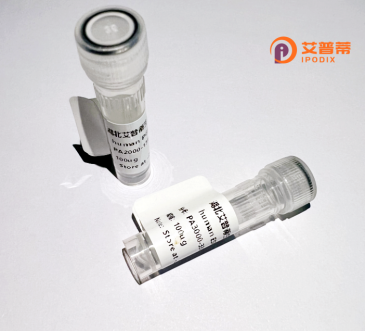
| 纯度 | >90%SDS-PAGE. |
| 种属 | Human |
| 靶点 | ARMC8 |
| Uniprot No | Q8IUR7 |
| 内毒素 | < 0.01EU/μg |
| 表达宿主 | E.coli |
| 表达区间 | 2-673aa |
| 氨基酸序列 | ACLLETPIR MSVLSEVTAS SRHYVDRLFD PDPQKVLQGV IDMKNAVIGN NKQKANLIVL GAVPRLLYLL QQETSSTELK TECAVVLGSL AMGTENNVKS LLDCHIIPAL LQGLLSPDLK FIEACLRCLR TIFTSPVTPE ELLYTDATVI PHLMALLSRS RYTQEYICQI FSHCCKGPDH QTILFNHGAV QNIAHLLTSL SYKVRMQALK CFSVLAFENP QVSMTLVNVL VDGELLPQIF VKMLQRDKPI EMQLTSAKCL TYMCRAGAIR TDDNCIVLKT LPCLVRMCSK ERLLEERVEG AETLAYLIEP DVELQRIASI TDHLIAMLAD YFKYPSSVSA ITDIKRLDHD LKHAHELRQA AFKLYASLGA NDEDIRKKII ETENMMDRIV TGLSESSVKV RLAAVRCLHS LSRSVQQLRT SFQDHAVWKP LMKVLQNAPD EILVVASSML CNLLLEFSPS KEPILESGAV ELLCGLTQSE NPALRVNGIW ALMNMAFQAE QKIKADILRS LSTEQLFRLL SDSDLNVLMK TLGLLRNLLS TRPHIDKIMS THGKQIMQAV TLILEGEHNI EVKEQTLCIL ANIADGTTAK DLIMTNDDIL QKIKYYMGHS HVKLQLAAMF CISNLIWNEE EGSQERQDKL RDMGIVDILH KLSQSPDSNL CDKAKMALQQ YLA |
| 分子量 | 75 kDa |
| 蛋白标签 | GST-tag at N-terminal |
| 缓冲液 | 冻干粉 |
| 稳定性 & 储存条件 | Lyophilized protein should be stored at ≤ -20°C, stable for one year after receipt. Reconstituted protein solution can be stored at 2-8°C for 2-7 days. Aliquots of reconstituted samples are stable at ≤ -20°C for 3 months. |
| 复溶 | Always centrifuge tubes before opening.Do not mix by vortex or pipetting. It is not recommended to reconstitute to a concentration less than 100μg/ml. Dissolve the lyophilized protein in distilled water. Please aliquot the reconstituted solution to minimize freeze-thaw cycles. |
以下是关于ARMC8的3篇代表性文献摘要归纳:
1. **《ARMC8 regulates β-catenin stability through the ubiquitin-proteasome system》**
- **作者**: Xie et al. (2017)
- **摘要**: 研究揭示了ARMC8通过招募E3泛素连接酶复合体调控β-catenin的泛素化与降解,影响Wnt/β-catenin信号通路活性,在结直肠癌细胞中促进肿瘤生长和转移。
2. **《ARMC8 promotes esophageal squamous cell carcinoma progression by stabilizing LASP1》**
- **作者**: Guo et al. (2019)
- **摘要**: 发现ARMC8在食管鳞癌中过表达,通过与LASP1蛋白相互作用抑制其泛素化降解,增强肿瘤细胞侵袭和迁移能力,提示其作为癌症治疗靶点的潜力。
3. **《ARMC8 is essential for neuronal morphogenesis and synaptic plasticity》**
- **作者**: Hou et al. (2018)
- **摘要**: 在小鼠模型中证实,ARMC8通过调节微管相关蛋白的稳定性参与神经突生长及突触形成,其缺失导致神经元发育异常和行为缺陷。
如需具体文献来源,可根据作者和发表年份在PubMed或Web of Science进一步查询。
Armadillo repeat-containing protein 8 (ARMC8) is a member of the armadillo (ARM) repeat protein family, characterized by tandem repeats of ~40 amino acid motifs that mediate protein-protein interactions. First identified in the early 2000s, ARMC8 has two major isoforms (α and β) generated by alternative splicing. Structurally, it features a conserved N-terminal ARM repeat domain and a divergent C-terminal region, enabling diverse binding partners.
ARMC8 gained attention for its role in the Cullin-RING E3 ubiquitin ligase (CRL) complexes, where it acts as a substrate receptor adaptor. It facilitates the ubiquitination and subsequent proteasomal degradation of specific targets, influencing processes like cell cycle regulation, DNA repair, and Wnt/β-catenin signaling. Notably, ARMC8 forms a complex with Niclosamide Sensitivity-Like (NHSL) proteins to regulate cadherin stability and adherens junction formation, impacting cell adhesion and epithelial integrity.
Dysregulation of ARMC8 is linked to cancer progression, as overexpression in tumors like glioblastoma or colorectal cancer correlates with poor prognosis, potentially through enhancing Wnt pathway activity or impairing DNA damage responses. Additionally, ARMC8 mutations are associated with developmental disorders, including ciliopathies and neurodevelopmental defects, highlighting its importance in embryonic development.
Recombinant ARMC8 proteins are widely used in vitro to study interaction networks and degradation mechanisms, aiding therapeutic exploration. Despite progress, ARMC8's full spectrum of functions and regulatory mechanisms remains under investigation, particularly its tissue-specific roles and crosstalk with other signaling pathways.
×